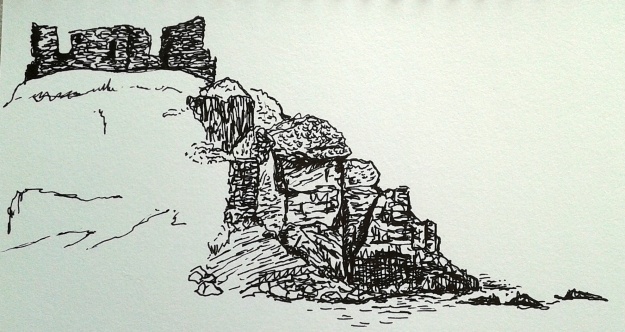I live in the UK. We have lots of weather here. Bucketloads of it! It comes from having a maritime climate, caught between the cold North Sea and the Atlantic Gulf stream. It characterizes our nation and our culture. We are famous for it.
Since I came to live here in Norfolk, I’ve been fascinated by clouds. Norfolk is famous for ‘Big Skies’. It impossible to explain that until you have been here and seen the wide open spaces. Norfolk is not as flat as everyone seems to think – Noel Coward has a lot to answer for, in my opinion – but what it does have is open vistas and large expanses of farm land reclaimed from sea. The result is fantastic cloudscapes every day. It colours the way people here live, and the way they view their lives. (If you are interested in how the landscape affects the people here, I can’t recommend highly enough the novel Salt by Jeremy Page.)
Weather gives atmosphere to writing and painting, as well as to life itself. Just look at this image by painter John Aitkinson Grimshaw, who specialised in moonlit landscapes.
 This one shows a wet day, and the slick cobbles and leaden sky are so evocative. What secret stories might be happening on those wet pavements, or behind those glowing shop windows?
This one shows a wet day, and the slick cobbles and leaden sky are so evocative. What secret stories might be happening on those wet pavements, or behind those glowing shop windows?
Compare these two images of the same building, the National Trust’s property at Ickworth in Suffolk.


Granted, the angle is slightly different, but look at the sky – one with glowering cloud, the other with sunshine. The atmosphere is significantly different in each, a sense of forboding in the right-hand image that simply isn’t there on the left.
You can use weather to prompt your creative work, as Grimshaw did, or you can use it to enhance it. You can see this is the paintings of John Constable, and the writings of Emily Bronte.
Writing Exercise:
Andrew Cowan, in his brilliant book on Creative Writing, suggests keeping a notebook solely on the weather, noting adjectives and descriptions every day for a year in order to inform your stories. It is hard to write credibly about a snowy day in a heatwave, for example, or vice versa, so a record of what weather feels, looks and smells like can be incredibly useful!
You might not want to go quite as far as recording the weather every day for a year, but try a writing exercise where you look out of the window – or even better, go outside and experience the weather first hand. What is the temperature like? Are there clouds, and if so, what kind? Is the air moist, crisp, cold, humid? What does it smell like? Are there ice crystals on the vegitation, or are the flowers in full and sumptuous bloom?
Record what you see, and then go a step further. How does this weather make you feel? What kind of events and interractions might happen on a day like this? Is it a foggy day for furtive meetings, a dark, moonless night for dastardly deeds, or a hot and sultry afternoon suggestive of languid adultery?
You could use weather to enhance the atmosphere of a scene, or you could contrast it to add clarity to the action. Imagine a meeting of high ranking spies in a sweltering noon, brows beaded with sweat and shirts stained dark under the arms, whilst all the time, the great business of state is being negotiated. Spend some time in your notebook playing with weather. Try out a scene in one kind of weather, then set it in the opposite. What kinds of problems and interesting ideas does this raise?
Happy Creating!








